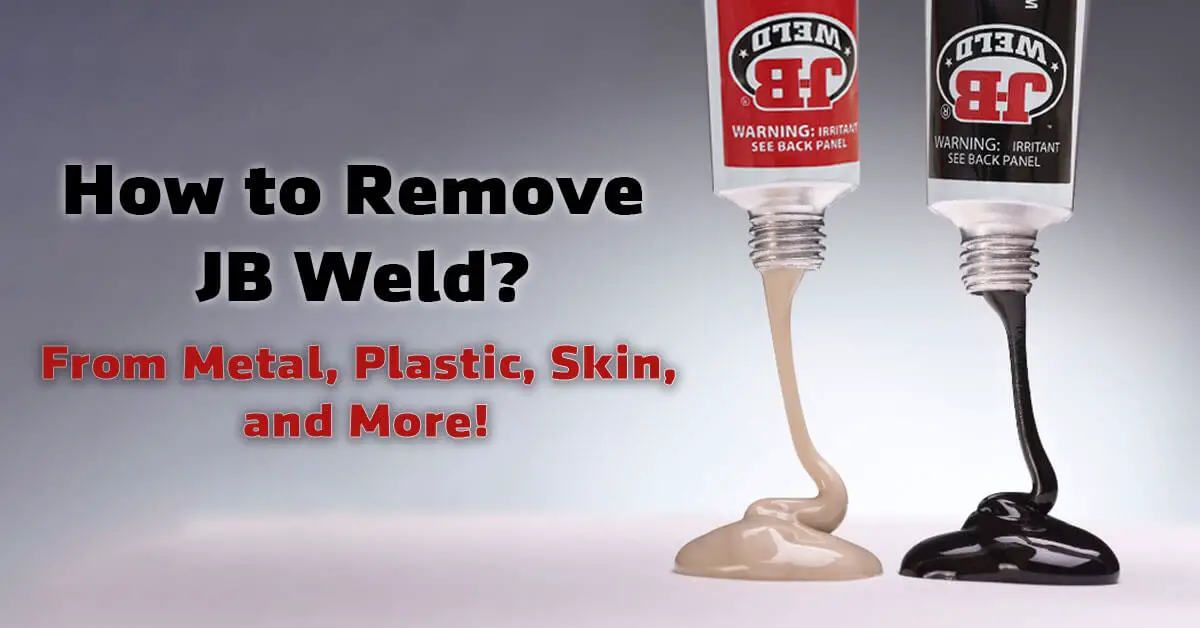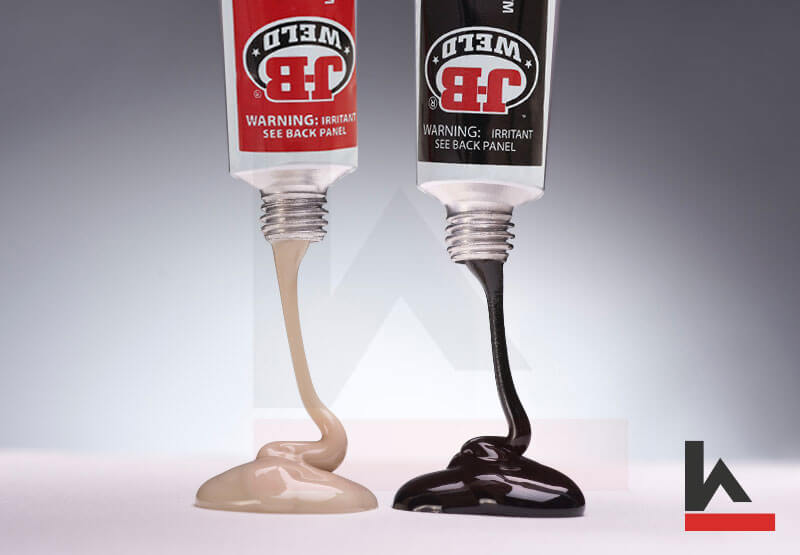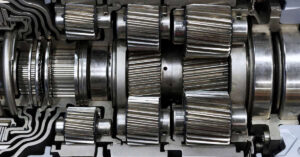JB Weld is a two-part epoxy adhesive known for its ability to create permanent, strong bonds on various surfaces. However, there may come a time when you need to remove JB Weld, either for repairs or to undo a mistake.
This article will explore different methods for safely and effectively removing JB Weld, including mechanical methods and chemical solvents. Whether working with metal, wood, or plastic surfaces, the following techniques will help you remove JB Weld without causing damage.
What is the Purpose to Remove J-B Weld?
The purpose of removing the JB Weld is often driven by the need to fix a mistake or repair a surface. JB Weld is a durable and strong adhesive that forms a permanent bond on various surfaces, making it difficult to remove once it has cured.
However, there may be instances where the bond needs to be undone. For example, removing the adhesive becomes necessary if you accidentally applied JB Weld in the wrong area or need to make adjustments to a project.
Additionally, removing any existing JB Weld is crucial if you are working on a new project and want to start with a clean surface. Whether it’s for repairs or a fresh start, removing the JB Weld requires mechanical methods or chemical solvents tailored to suit the specific surface and desired result.
By understanding the purpose and appropriate techniques, you can successfully remove JB Weld without causing damage.
Methods to Remove JB Weld | What Will Dissolve JB Weld Epoxy?
JB Weld is known for its permanent and strong bond and is a go-to option for various repair tasks. However, there may be instances where you need to remove JB Weld for rework or repairs. So, what will dissolve JB Weld?
Remove JB Weld Using Heat
Heat is an effective method for JB Weld removal. Tools such as a heat gun, propane torch, or soldering iron are useful in this process.
Ensure your workspace is well-ventilated to minimize inhalation of harmful fumes. Prioritize safety – wear goggles and gloves. Then, apply heat, maintaining around 600 degrees Fahrenheit, to soften the JB Weld to a fluid state. Remember to protect the underlying surface by moving the heat source around to avoid overheating in one spot.
Once it’s adequately melted, gently scrape it off with a putty knife or wire brush, taking care not to cause any damage. Allow the area to cool before proceeding further.
Remove JB Weld Using Chemicals
Household chemicals like vinegar or acetone can aid JB Weld removal if the heat doesn’t appeal. A soaked cloth with vinegar placed on the JB Weld surface and left for a few hours will break down the epoxy glue, softening it for removal.
Acetone is another effective chemical for removing JB Weld. Acetone is a strong solvent that can dissolve the bond created by JB Weld.
Powerful agents like methylene chloride or sulfuric acid can degrade the epoxy layer efficiently. However, it is important to handle these potent chemicals with care.
Ensure you prioritize safety when handling these chemicals – protect your eyes and hands, and maintain good ventilation. Do not mix methods like heat and chemicals, which could result in dangerous reactions. Wash the area thoroughly after successful removal to ensure no residue remains.
Will Acetone Remove JB Weld?
Acetone, a commonly used solvent, helps remove excess JB Weld but is unsuitable for dissolving fully hardened JB Weld. Here’s a step-by-step guide to using acetone:
- Work in a well-ventilated area and wear safety goggles and gloves.
- Apply acetone directly to the JB Weld area with a clean cloth or sponge.
- Allow the acetone to sit for a few minutes to soften and loosen the epoxy.
- Gently scrape the loosened JB Weld with a putty knife or wire brush.
- Repeat the process as needed, adding more acetone if necessary.
- After removing the JB Weld, wash the surface with soap and water to remove any acetone residue.
Remember, acetone is ineffective for fully cured JB Weld; in such cases, alternative methods like heat application or mechanical means, like grinding or scraping, could be necessary.
Will Vinegar Remove JB Weld?
Vinegar can be used as a DIY solvent to remove JB Weld. However, it releases toxic fumes, so work in a well-ventilated area. As with acetone, appropriate safety precautions are necessary.
The process for using vinegar is similar to that of acetone:
- Ensure you’re working in a well-ventilated area, wearing safety goggles and gloves.
- Apply vinegar directly to the JB Weld, ensuring the epoxy is saturated.
- After a few minutes, the vinegar will weaken and soften the JB Weld.
- Using a putty knife or a wire brush, carefully scrape off the loosened JB Weld without applying too much pressure to avoid surface damage.
- If required, repeat the process of application and scraping.
- Once the epoxy is fully removed, wash the surface with soap and water to remove any vinegar residue.
Remove JB Weld Using Mechanical Techniques
Lastly, a file and grinder may be the perfect tools for larger jobs of JB Weld removal. Here’s a brief guide:
- Tool Selection: A hand file with medium or fine grit is apt for smaller or delicate tasks. For larger requirements, an angle grinder is recommended.
- Preparation: Clean the surrounding surface area to ensure no interference from dirt or debris.
- Grinding/Filing: Start gently, applying light pressure in controlled motions. This is to prevent any unwanted damage to the underlying material.
- Progress Check: Regularly evaluate how much JB Weld you’ve removed and make necessary adjustments to your technique.
- Clean-up: Post the removal, thoroughly clean the surface to eliminate any residual flakes.
Safety should always be at the forefront of any operation involving power tools. Wear appropriate safety gear and work in a well-ventilated area.
JB Weld Removal Process: Best Way to Remove JB Weld
Removing JB Weld can be challenging due to its strong and permanent bonding characteristics. However, using the right tools, techniques, and safety precautions can help remove JB Weld effectively.
The methods provided here will help safely and efficiently remove JB Weld from different surfaces, such as metal, wood, and plastic.
Remove JB Weld from Metals Surface
Removing JB Weld from metal surfaces can be a challenging task. However, it can be done effectively with the right techniques and tools. Here is a step-by-step guide on how to remove JB Weld from metal:
1. Heat method: Apply heat using a heat gun or propane torch to soften the adhesive. Ensure a well-ventilated work area and use appropriate safety gear.
2. Grinding or scraping method: If heat is unsuccessful, try grinding or scraping with an angle grinder or wire brush attachment. This method requires patience and elbow grease.
3. Chemical solvent method: If necessary, use a chemical solvent such as methylene chloride or sulfuric acid to remove the JB Weld. Apply the solvent, then scrub the area using a wire brush or putty knife.
Always prioritize safety and ensure the surface is clean and residue-free after removal.
Remove JB Weld from Aluminum
Removing JB Weld from aluminum surfaces requires a careful approach to avoid damaging the metal. Here are three effective methods to remove JB Weld from aluminum and the necessary precautions:
1. Heat method: Apply heat cautiously to soften the adhesive. Don’t overheat the aluminum; extreme heat can cause warping or discoloration.
2. Grinding/Scraping method: Use gentle pressure to remove JB Weld mechanically using an angle grinder or wire brush attachment. Take your time and apply gentle pressure to prevent damaging the metal.
3. Chemical method: Following the manufacturer’s instructions, choose a suitable solvent like methylene chloride. Use a wire brush or a putty knife to remove the softened adhesive.
Take all necessary safety precautions and clean the aluminum surface thoroughly afterwards.
Remove JB Weld from Plastic
Removing JB Weld from plastic can be challenging, but with the right approach, it can be done effectively. Here are the steps to follow:
- Scrape off as much of the JB Weld as possible using a razor blade or putty knife cautiously.
- Use acetone or vinegar to help dissolve the remaining adhesive. Soak a clean cloth in the chosen solvent, then gently apply it to the affected areas.
- Allow the solvent to work for several minutes, then scrub gently.
Repeat the process until the JB Weld is completely removed. Clean the surface with soap and water to remove any residue.
Remove JB Weld from Skin
Removing JB Weld from the skin can be challenging, but it’s important to act quickly before the adhesive cures.
- Scrape off excess JB Weld gently using a plastic tool, careful not to irritate or break the skin.
- Wash the affected area with warm soapy water. Use a soft cloth or sponge to scrub gently.
- If needed, use vinegar as a gentler alternative to acetone for dissolving adhesive.
It’s important to note that JB Weld can cause skin irritation, especially if left on for a prolonged period. If skin irritation occurs, discontinue vinegar or acetone and consult a medical professional.
Remove JB Weld from Clothes
Spills or drips of JB Weld on clothing can be frustrating, but it is possible to remove the adhesive with the right approach. Here are some steps to help you remove JB Weld from clothes effectively.
- Address the spill immediately to prevent the adhesive from drying and setting permanently.
- Carefully scrape any excess adhesive using a plastic putty knife or similar tool.
- Apply a safe solvent or liquid weld remover to the stained area and let it sit for a few minutes.
- Gently scrub the stained area using a clean cloth. Work in a circular motion, applying some pressure to loosen the adhesive from the fabric.
- Launder following the fabric care instructions. Use warm water and mild detergent to wash the garment. Check if the stain is completely gone before drying the clothes.
Remember, the effectiveness of the removal process may depend on the fabric type and the severity of the stain. If the stain persists, it may be best to seek professional help or consult care instructions provided by the manufacturer.
Essential Tools for JB Weld Removal
To efficiently and safely remove JB Weld, you’ll need the following tools:
- Safety Equipment: Always wear safety goggles and gloves to protect yourself from potential harm during removal.
- Heat Source: A heat gun or propane torch can soften the JB Weld, making removing it easier.
- Mechanical Tools: Depending on the surface type, you may need tools like an angle grinder or a wire brush to physically remove the JB Weld.
- Chemical Solvent: For some situations, a chemical solvent such as methylene chloride or sulfuric acid might be required to dissolve and break down the adhesive.
- Cloths: Clean and tack cloths can be used to wipe away loosened JB Weld and ensure a clean surface.
Always follow the safety instructions provided by the manufacturers. If you use the right tools and maintain safety measures, effectively removing JB Weld is achievable.
How to Use Each Tool
Heat Gun or Propane Torch: These tools are useful for applying heat to JB Weld, softening it for easier removal. Ensure that the surface you’re working on can endure the extreme heat and avoid any contact with the heated JB Weld. Using a heat gun or propane torch, you can effectively remove JB Weld and prepare the surface for necessary repairs or refinishing. Use these tools in a well-ventilated area to avoid inhaling fumes.
Angle Grinder: The angle grinder is an effective tool for grinding away JB Weld. However, you should be careful to avoid damaging the surface underneath. Ensure you have protective gloves, safety glasses, and a face mask.
Putty Knife: A putty knife’s flat, wide blade makes it an effective scraping and removal tool for hardened epoxy. Make sure to scrape gently to minimize any potential damage to the underlying material.
Wire Brush: A wire brush can scrub and remove residual JB Weld effectively. Use it at a slight angle against the JB Weld, applying moderate pressure using short, firm strokes. After brushing, wipe away any loose debris with a clean cloth or brush.
Chemical Solvent: Acetone is a common solvent that can soften JB Weld for easier removal. Apply it directly onto the hardened epoxy and let it sit for a few minutes. Once the JB Weld has softened, gently scrape it away with a putty knife or a similar tool.
Note: Always test the solvent on a small, less noticeable surface area before full application.
Clean Cloth: After JB Weld removal, a clean cloth can be used to wipe away residual epoxy for a clean, smooth surface. Remember to dispose of the cloth properly as it may have traces of the JB Weld or chemical solvent.
Regardless of the method used, it is always crucial to maintain safety measures while removing JB Weld.
Conclusion
Three primary methods for effectively removing JB Weld are heat application, mechanical abrasion, and chemical solvents.
When using heat, tools such as heat guns or propane torches soften JB Weld, making it easier to remove. When working with these tools, it’s important to be cautious, ensure proper ventilation, and follow safety guidelines.
Mechanical abrasion, which involves using an angle grinder or wire brush, physically scrapes away the epoxy. This method requires significant effort but may not be suitable for delicate surfaces due to its abrasive nature. It’s essential to maintain control and protect the underlying surface while working.
Chemical solvents, like acetone, can help dissolve JB Weld. However, their effectiveness may differ depending on the type of JB Weld and the situation. Always practice caution when handling chemicals and opt for a well-ventilated area to ensure safety.
When choosing a removal method, consider factors such as the type of JB Weld, bond duration and temperature, and the treated area—conducting a trial run on a small, inconspicuous area before the full-scale removal process is advised.
Overall, removing JB Weld requires a careful approach and a suitable method, with safety being the top priority, followed by adherence to necessary precautions.
You may also want to read: What is J-B Weld? How JB Weld Cure Faster?






